All electric motors are produced with plates on the body, from which you can find out the main characteristics of the electric motor: its brand, consumed rated operating current and power, speed, motor type, efficiency and cos (fi). Also, these data are indicated in the passport to the device.
Of all options the most important for the connection are: the power of the electric motor and the current consumed, do not confuse it with the starting one. It is these data that allow us to determine the sufficiency of power for the drive, the required cable cross-section for connecting the motor and select the automatic machine and thermal relay that are suitable for protection.
But it happens that there is no passport or plate, and to determine these values it will be necessary to make measurements. How to find out the power, operating current and reduce the starting, you will learn further from this article.
How to determine the power of an electric motor
The easiest way is to look at the plate and find the value in kilowatts. For example, in the picture it is 45 kW. Please note that this value on the plate indicates the consumed active power from the mains. The total power will be equal to the sum of active and reactive power. Electric meters in a house or garage, only the consumption of active electricity is considered, and accounting is carried out only at enterprises using special meters. The higher cos(fi) the motor has, the smaller the reactive energy component will be at full power. Do not confuse cos(fi) with efficiency. This indicator shows how much electricity is converted into useful mechanical work, and how much into useless heat. For example, an efficiency of 90 percent indicates that a tenth of the electricity consumed is spent on heat losses and friction in bearings.
You must keep in mind that the rated power is indicated in the passport or on the plate, which will be equal to this value only if the optimum load on the shaft is reached. At what it is not worth overloading the shaft for a number of reasons, it is better to choose a more powerful motor. At idle, the current will be much lower than the nominal value.
How to determine the rated power of an electric motor? On the Internet you will find many different formulas and calculations. For some it is necessary to measure the dimensions of the stator, for other formulas you will need to know the magnitude of the current, efficiency and cos (fi). My advice is don't bother with all this. Better than these calculations will still be practical measurements. And for their implementation, nothing is needed at all.
How to determine the power of any electrical appliance in a house or garage? Of course with the help of an electricity meter. Before starting the measurement, turn off all electrical appliances from sockets, lighting and everything that is connected to the electrical panel.
Further if you have an electronic meter like Mercury, everything is very simple, you need to turn on the motor under load and drive for about 5 minutes. The electronic display should show the load value in kW connected to the meter at the moment.
If the engine is underpowered, then for higher accuracy, you can calculate the revolutions of the disk. For example, in one minute he made 10 full revolutions, and the counter says 1200 revolutions \u003d 1 kW / h. 10 multiplied by the number of minutes in an hour and we get 600 revolutions per hour. We divide 1200 by 600 and get 500 watts or 0.5 kW. The longer you measure, the more accurate the data will be. But the time must always be a multiple of a full minute. Then divide 60 by the number of minutes of measurement and multiply by the counted revolutions. After that, the value of revolutions equal to one Kilowatt / hour for your electric meter model is divided by the result obtained and we obtain the required power value.
How to determine the consumed current of the electric motor
Knowing power, you can easily calculate the amount of current consumed. For 3 phase motors, connected according to the star circuit at 380 Volts, it is necessary to multiply the power in kilowatts by 2. For example, with a power of 5 kilowatts, the current will be 10 amperes. Again, keep in mind that the motor will take such a current only under a load as close as possible to the nominal value. A semi-loaded electric motor, and even more so at idle, will consume much less current.
To determine the current in single-phase networks, you need to divide the power by the voltage. For example, when the engine is running, the voltage at the place of its connection is 230 volts. This is important because after the load is turned on, the voltage is likely to drop at the point where the motor is connected.
If, for example, the power of a 220-volt motor, according to measurements, turned out to be 1.5 kW or 1500 watts. We divide 1500 by 230 Volts and we get that the operating current of the engine is approximately 6.5 Amps.
Motor starting current
At startup of any type of electric motor, a starting current occurs from 2 to 8 times the rated current in the operating mode of the electric motor. The value of the starting current depends on the type of motor, rotation speed, connection scheme, the presence of a load on the shaft and other parameters. 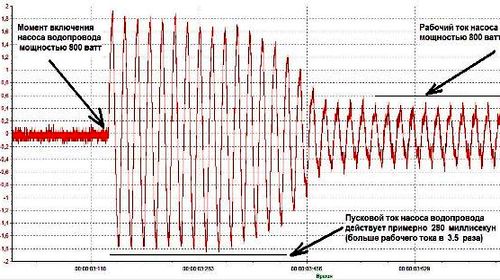
Starting current arises because at the moment of launch a very strong magnetic field is induced in the windings, which is necessary to move and spin the rotor. When the motor is turned on, the resistance of the windings is small, and therefore, according to Ohm's law, the current increases with a constant voltage in the circuit section. As the motor spins up, EMF or inductive reactance and the current starts to decrease to the nominal value.
These bursts of reactive energy negatively affect the operation of other electrical consumers connected to the same power line, which causes the occurrence of voltage surges or surges that are especially detrimental to electronics.
Halve the starting current it is possible when using a thyristor unit specially designed for this purpose, and preferably with the help of a soft start device (UPZ). A CCD with a lower starting current and one and a half times faster starts the motor compared to a thyristor start. 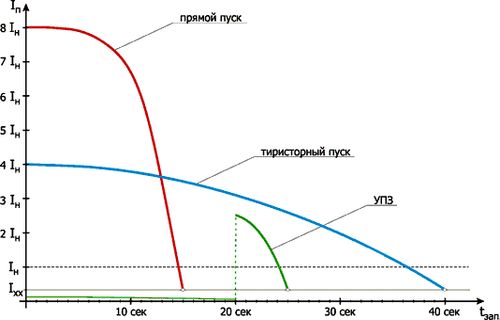 Soft starters are suitable for both synchronous and asynchronous motors. UPZ are issued by the enterprises of Ukraine and Russia.
Soft starters are suitable for both synchronous and asynchronous motors. UPZ are issued by the enterprises of Ukraine and Russia.
To start a three-phase asynchronous motor Today, frequency converters are also often used. Their wide distribution is still restrained only by the price. By changing the values of the frequency of current and voltage, it is possible not only to make a smooth start, but also to regulate the speed of rotation of the rotor. In another way, as soon as a change in frequency electric current, it is not possible to regulate the speed of rotation of an asynchronous motor. But you should be aware that the frequency converter creates interference in the mains, therefore, to connect electronics and household appliances use . 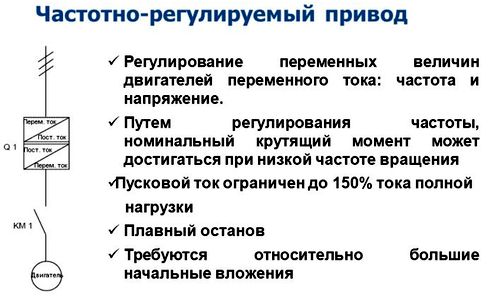
Using the soft starter and frequency converter allows not only to maintain the stability of the power supply for you and your neighbors connected to the same power supply line, but also to extend the life of the electric motors.
Similar materials.
Before considering the difficulties that may arise when starting a three-phase electric motor, we recall general provisions. As an example, let's take a small engine and decipher the inscription on the plate attached to it (Fig. 62.1).
Ph 3 - W 375 - according to this inscription, the motor has three phases, and its output power is 375 watts.
220/380 V - the engine can run on AC three-phase current 220 V (connection of the stator windings is carried out according to the "triangle" Δ) and 380 V (connection according to the "star" Y scheme).
1.7 / 1A - the operating current of the motor at rated load is 1.7A, according to the "triangle" circuit and 1 A - according to the "star" circuit (Fig. 62.2).
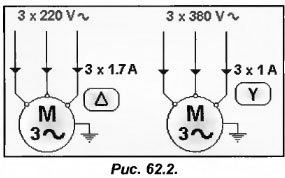
Imagine that this motor is used to drive a compressor. It is known that when the discharge pressure changes, the power on the compressor shaft and the current consumed by the motor will also change. As the discharge pressure increases, the current increases and vice versa.
It turns out that the current consumed by the motor at the moment may not correspond to that indicated on the plate, but at the same time, the motor should never exceed it. The current consumed by the motor will be equal to 1 A only if the voltage in the network is 380 V (the windings are connected according to the “star” scheme) and the power on the compressor shaft exactly corresponds to 375 W (Fig. 62.3).
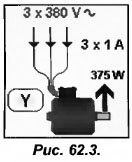
In turn, the current consumed by the motor will be 1.7 A when the mains voltage is 220 V (which is quite rare) and the required power on the compressor shaft is 375 W (Fig. 62.4).
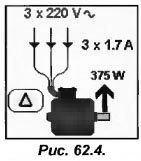
Recall. What is the power it consumes three-phase motor can be determined by the formula:
P \u003d U x I x √3 x cosφ,
where U is the mains voltage, I is the current consumed, and cosφ is the power (for small motors cosφ=0.8).
Thus, the power of our engine will be:
- voltage 220 V: 220 × 1.7x3 x0.8 = 520 W;
- voltage 380 V: 380 × 1x3 x0.8 = 520 W.
- the power consumption of the motor does not depend on the network;
- the power consumption (520 W) exceeds the shaft power (375 W) indicated on the rating plate. The specified figure corresponds to the maximum value that can be achieved on the shaft of this motor.
So in the example we are considering, the motor power consumed from the network is 520 W, and only 375 W on the shaft. Based on this, the losses are 520-375 \u003d 145 W, which only heat environment(Fig. 62.7).
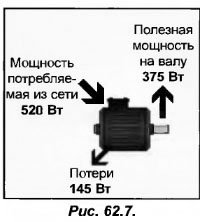
At the same time, the coefficient of performance (COP)? motor is determined by the ratio of useful shaft power to the power consumed from the network:
From this it follows that 72% of the energy consumed by the engine is spent on useful work. At the same time, 28% of the energy consumed is wasted.
Note that the engine we are considering is a common model. On his terminal box there are 6 terminals, conditionally marked U-V-W and Z-X-Y (Fig. 62.8).
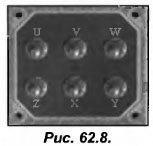
You should be careful, because the bottom row terminals are not alphabetically labeled ZXY, not XYZ. Now let's check the order of connecting the windings to the terminals and get the following fig. 62.9. This motor has three windings, which are connected to the terminals as follows: U-X; V-Y; W-Z.
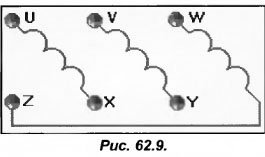
If the engine is in good condition, then the resistance between its terminals U-X; V-Y; W-Z with the terminals removed will be the same (if not, then it happened short circuit or a break occurs).
Hello site visitors site, and in today's article we will analyze how to do this incomprehensible calculation of the electric motor current. Every self-respecting electrician, whose robot is connected with the maintenance of electrical machines, simply must know this. At one time, I also remember that I was very interested in this when I was transferred from one workshop to another. Specifically, work as an electrician.
Before that, I already touched on the topics of electric motors a little when I wrote about, and when I wrote what they are.
Well, now let's proceed specifically to the calculation itself. Let's say you have a three-phase asynchronous electric motors alternating current, rated power, which is 25 kW, and you want to know what it will have rated current.
There is a special formula for this: I n = 1000P n /√3 (η n U n cosφ n),
Where P n is the power of the electric motor; measured in kW
Un is the voltage at which the electric motor operates; AT
η n is the efficiency factor, usually this value is 0.9
well, cosφ n is the power factor of the engine, usually 0.8.
The last two values are usually written on the factory tag, although they are almost the same for all engines. But still you need to take the data from the factory tag on the engine.
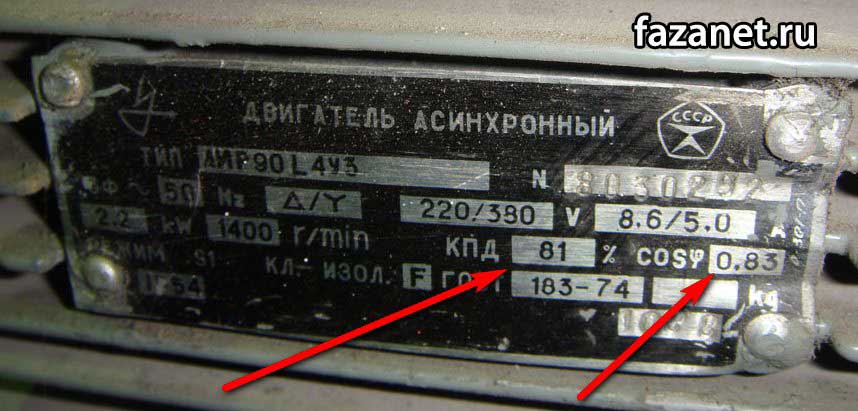
This is how in this picture all the values are visible, but the current is not. Only if the efficiency is written as 81%, then for the calculation you need to take 0.81.
Now let's substitute the values of I n \u003d 1000 25 / √3 (0.9 380 0.8) \u003d 52.81 A
For those who do not remember how much √3 will be, I remind you - it will be 1.732
That's it, all calculations are completed. Everything is very easy and simple. According to my sample, you can easily calculate the rated current of the electric motor, you just need to substitute your data.
How to determine the current of the electric motor in practice.
That's all for me. Bye.
Sincerely, Alexander!





